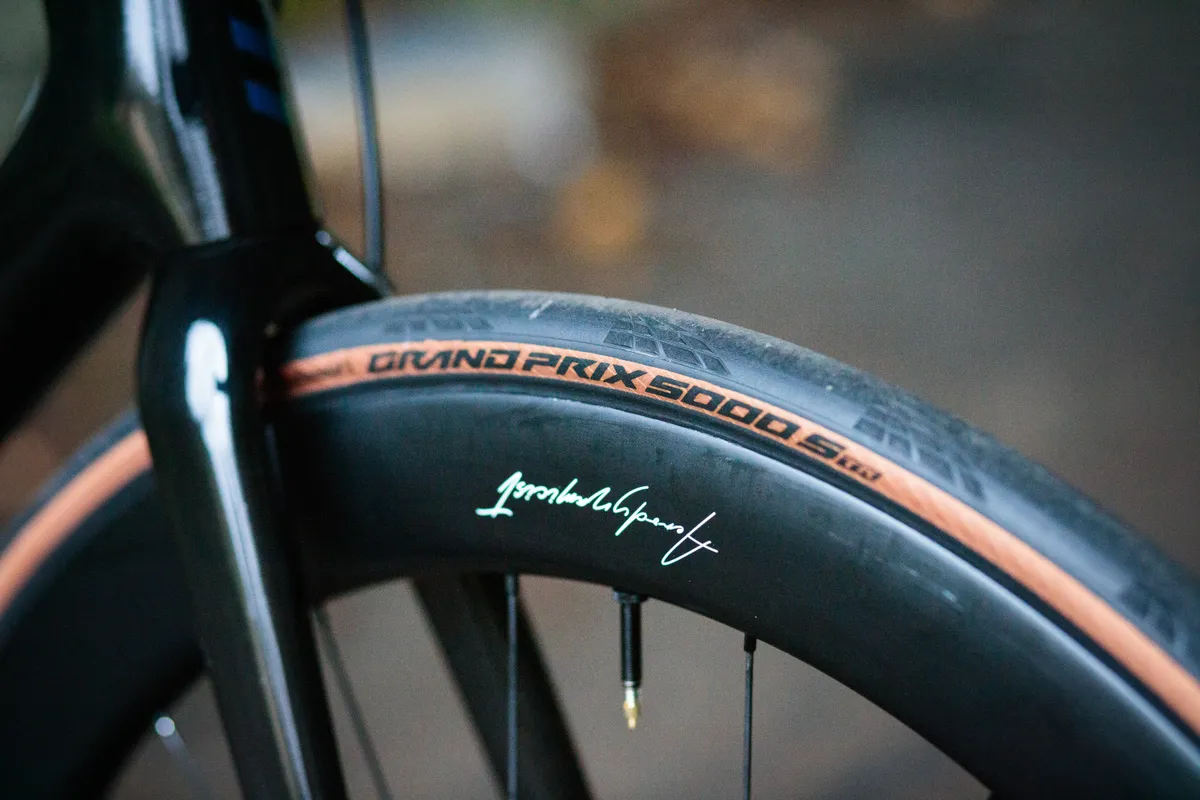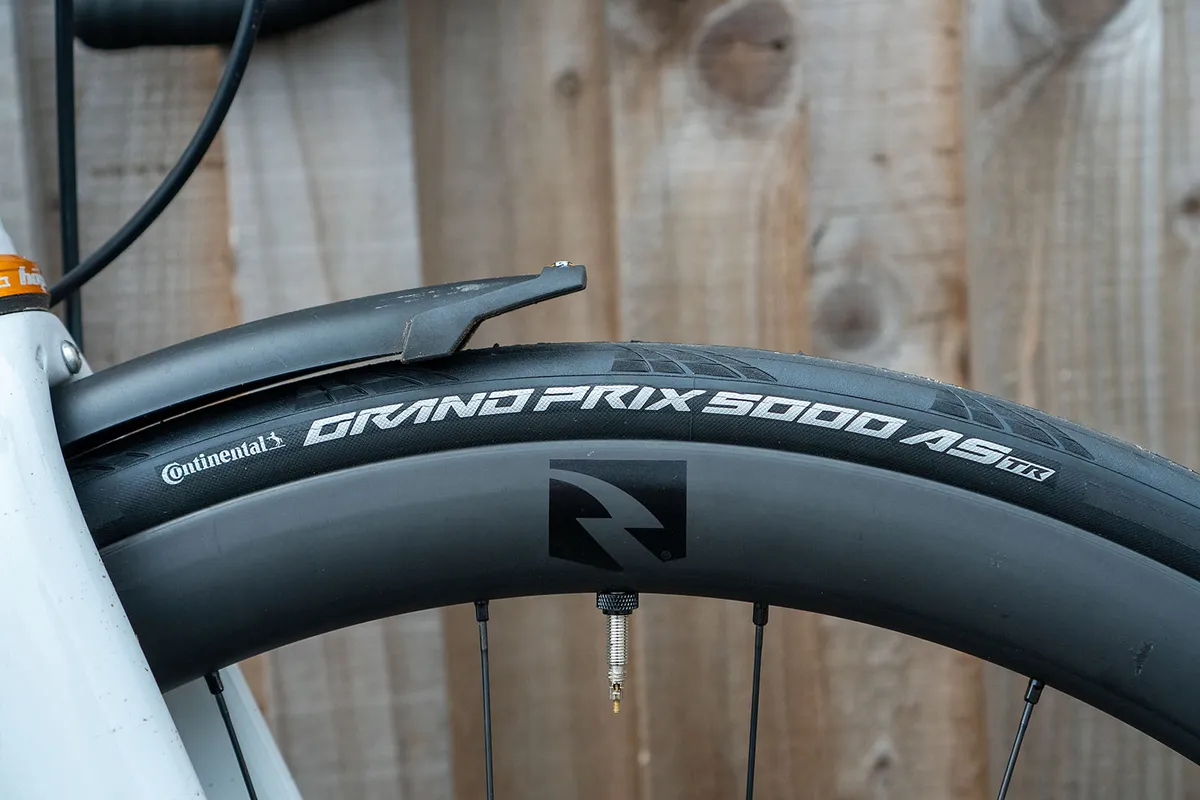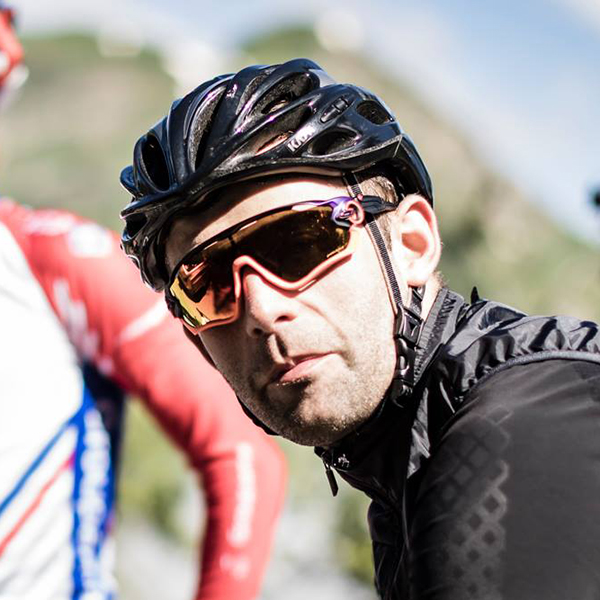Continental, DT Swiss and Swiss Side have partnered to develop the Aero 111 – a tubeless aerodynamic road racing tyre designed specifically for the front wheel.
First spotted at the Tour de France but now officially launched, the design sees cavities in the tread function as vortex generators, which are said to help air stay attached to the front wheel, in order to improve aero efficiency and handling.
While the tyre is optimised for use with DT Swiss’ ARC, AR and A, and ERC, ER and E wheels, Continental says it will provide a “competitive advantage” to riders using wheels from other brands, too.
The tyre is available exclusively from online retailers Bike24 (Europe) and Competitive Cyclist (US), as well as direct from Swiss Side, costing €119.95 / $120.95.
Setting a "new benchmark" in aero performance

The Continental Aero 111 tyre features 48 cavities set within the tread, referred to as “vortex generators”, which the brand says are intended to help control the airflow as it passes over the front tyre and wheel.
Developed with aerodynamics specialists Swiss Side, and using DT Swiss wheels to model performance, the pattern is said to trip the airflow, creating a more turbulent boundary layer (the layer of air closest to the surface of the rim).
The air is then said to stay attached to the rim for longer, delaying flow separation and, in turn, maximising the ‘sailing effect’.

For context, the pursuit of more efficient aerodynamics is often centred on the idea of keeping air attached to the profiled body for longer – when air becomes prematurely detached from the body (otherwise known as separation of flow), it creates a wake, which causes drag.
The sailing effect is generally maximised when the airflow is controlled to the point where it creates a higher pressure zone behind the profiled body. The higher pressure then effectively ‘pushes’ the body into the lower pressure area ahead of it.
Wind tunnel testing

When mounted to a 62mm-deep DT Swiss ARC 1100 Dicut wheel (which has a 20mm internal rim width), DT Swiss says a 700 x 26c Aero 111 tyre is slightly more aerodynamically efficient compared to a 700 x 25c Continental Grand Prix 5000 S TR tyre when exposed to 30kph winds at 0-10 degrees of yaw.
Between 10-20 degrees of yaw, though, the Aero 111 tyre is claimed to be up to around 6 watts faster, which corresponds to an approximate -2.5 watt sailing effect, according to Continental.

Tested at 45kph, the main benefit is seen at 15-20 degrees of yaw, delivering up to around 18 watts improvement (translating to an approximate -10 watt sailing effect), according to the testing figures provided.
Tests were also conducted at 30kph using a 700 x 29c Aero 111 tyre mounted to a 45mm-deep DT Swiss ERC 1100 Dicut wheelset, compared to a 700 x 28c GP 5000 S TR tyre.

The graph reveals similar aerodynamic performance up to around 7 degrees of yaw, after which – up to 20 degrees of yaw – the Aero 111 tyre is shown to be up to 4 watts more efficient.

Tested against selected competitors from Schwalbe, ENVE, Vittoria, Cadex and Pirelli, the Aero 111 is also shown to be more efficient across the 0-20 degree yaw angle range.
Again, this comes from the testing figures provided as part of the Aero 111 launch.
The Schwalbe Pro One TLE (700 x 25c size) is the closest-performing tyre, overall, at 30kph, and the Cadex Aero Tubeless (also 700 x 25c size) closest at 45kph.

It’s worth noting that, when asked, the brands wouldn’t supply exact figures for the tests – so all figures and comparisons stated (above and below) are extrapolated from the graphs supplied by the brands, with a margin for error.
That said, Swiss Side confirms that all graphs display the aggregated results of multiple tests carried on a rolling wheel rig in Swiss Side’s wind tunnel, and that further tests carried out on full bike setups corroborate the findings.
Swiss Side also says tests have also been carried out on wheels with 20, 22 and 24mm internal rim widths, with similar trends seen.
Perhaps unsurprisingly, given the tyre is developed with DT Swiss, it’s not disclosed what alternative wheels the Aero 111 tyre has been tested with.
Improved handling

The brands also claim that the Aero 111 tyre brings improvements to bike handling, thanks, they say, to its ability to reduce the force of the air detaching from the wheel-tyre system, compared to a Continental GP 5000 S TR tyre.
At both 30 and 45kph, the Aero 111 tyre is said to bring consistently-increasing ‘steering moment’ force (measured in Newton-metres) from zero to +/- 20 degrees of yaw, rather than the sudden change typically seen with a GP 5000 S TR tyre.

In this instance, a 700 x 26c Aero 111 tyre was fitted to the same DT Swiss ARC 1100 Dicut wheel, but pitched against a wider 700 x 28c GP 5000 S TR.

The grey lines in the graphs show the sudden decrease of required steering force (shown to be around 10 degrees of yaw at 30kph, and 15 degrees of yaw at 45kph), effectively illustrating the moment at which the air typically detaches from the test wheel when using the GP 5000 S TR reference tyre.
The brands say that this sudden change in force acting upon the wheel causes less stable handling, bringing about more steering corrections, and in turn forces the rider to slow down (or use a less aerodynamic position).
GP 5000 S TR DNA

Continental says the Aero 111 tyre uses the same technologies as its Grand Prix 5000 TR family of tyres, which includes the GP 5000 S TR, GP 5000 AS TR and GP 5000 TT TR.
When asked, Continental confirmed that the tyre is most similar to the GP 5000 S TR in terms of construction, and that the tyre is suitable for use on both hooked and hookless rims.
Continental says the Aero 111 tyre uses its BlackChili compound, contributing to “low rolling resistance and exceptional grip in both wet and dry conditions”, although it has been modified slightly to accommodate the vortex generators.
While the brand doesn’t offer any comparison with competitors, our own rolling resistance testing has showed the GP5000 S TR to be competitively efficient versus rival tyres, while offering good grip and suppleness on the road.

The brand says its ‘Active Comfort Technology’ also helps the tyre absorb vibrations, with a 2 x 220 TPI (thread-per-inch) casing.
Ultimate expected tyre life isn’t published, but the brands say that the tyre has been used for over 2,500km before any negative aerodynamic impact is seen from the worn vortex generators.
The brands also say the Decathlon-AG2R La Mondiale WorldTour team has been using the tyre in training since December 2023, with no negative reports (relative to the GP 5000 S TR tyre).
A 700 x 26c tyre is said to weigh 250g, while a 700 x 29c tyre is quoted at 280g – for comparison, we’ve weighed a 700 x 28c GP 5000 S TR tyre at 280.6g.
Continental Aero 111 pricing and availability

The Continental Aero 111 tyre is available today, from Bike24 in Europe and Competitive Cyclist in the US, as well as from Swiss Side.
The tyre is set to cost €119.95 / $120.95. Both 700 x 26 and 29c sizes come in a black sidewall only.
UK customers are able to buy from Bike24 and Swiss Side (with the price subject to exchange rates and import duties from the EU).
DT Swiss also offers the Aero 111 tyre with selected wheelsets (listed below) as part of a new wheel-tyre system for a €100 upcharge, fitted with a TPU (thermoplastic polyurethane) inner tube. A GP 5000 S TR tyre is fitted to the rear wheel.
- DT Swiss ARC 1100 Dicut 80
- DT Swiss ARC 1100 Dicut 62
- DT Swiss ARC 1100 Dicut 50
- DT Swiss ARC 1100 Dicut 38
- DT Swiss ARC 1400 Dicut 80
- DT Swiss ARC 1400 Dicut 62
- DT Swiss ARC 1400 Dicut 50
- DT Swiss ARC 1400 Dicut 38
- DT Swiss AR 1600 Spline 30
- DT Swiss A 1800 Spline 30
- DT Swiss ERC 1100 Dicut 45
- DT Swiss ERC 1100 Dicut 35
- DT Swiss ERC 1400 Dicut 45
- DT Swiss ERC 1100 Dicut 35
- DT Swiss ER 1600 Spline 30
- DT Swiss E 1800 Spline 30
